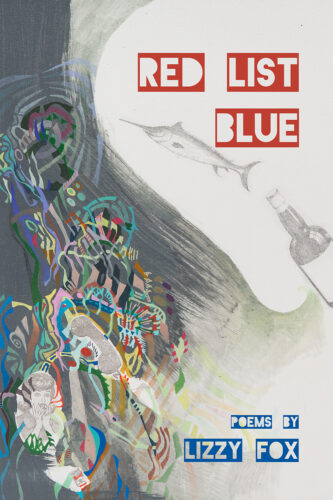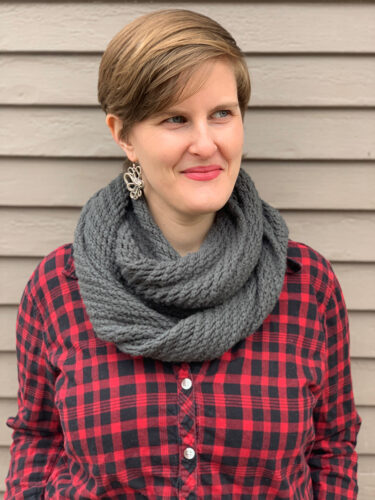Lizzy Fox, 2017 MFA in Writing
VCFA Writing alumnx and former Associate Director of the MFA in Writing & Publishing Lizzy Fox’s debut poetry collection, Red List Blue*, will be hitting the shelves in January 2021. In celebration of her upcoming release, we virtually spoke with Fox about her collection, her passion and connection to her work as a teaching artist, and how VCFA impacted her art and career.
 ON HER UPCOMING POETRY COLLECTION, RED LIST BLUE
ON HER UPCOMING POETRY COLLECTION, RED LIST BLUE
My forthcoming book, Red List Blue, has three thematic threads: environmental crisis, mental health, and relationships. I’m interested in the connection between personal grief and the global grief we hold for the natural world. I remember [VCFA’s] David Wojahn once saying that all poetry is elegiac to some degree, and I believe that’s true of my work. There is also a series of poems in Red List Blue that I think of as the “anxiety series.” They are a set of poems detailing the ways anxiety shows up in my behavior and how it feels a as a physical sensation. That’s a newer thread for me, and those poems have helped me to make my anxiety feel both more valid and more manageable.
I hope that Red List Blue gives people a space for their grief and their hope. As we experience the effects of climate change and late capitalism, there is so much grief for all of us to hold. I believe we have to move through that grief—as well as through the everyday grief and longing we experience simply by living a human life—in order to find the vision and strength needed for a just and sustainable world.
Red List Blue will be released by Finishing Line Press in January 2021, though it’s available for preorder now. There will be an online Book Release on February 12 hosted by Bear Pond Books and the Kellogg-Hubbard Library, as well as a handful of other readings around that time (some hosted by VCFA!). Upcoming readings are listed on my website, www.lizzyfoxpoetry.com.
ON THE IMPACT OF VCFA ON HER WRITING
Being a student in the MFA in Writing program taught me how to read and how to write. I didn’t have the discipline before then to write routinely or to read for craft, and I didn’t have the technical skill I needed to make my poems better. Working for the MFA in Writing & Publishing program gave me the skills and confidence I needed to put my work out in the world. I often call it my postgraduate program because I really had no idea how to publish my work. I don’t know that I ever would have figured it out without those three years getting to know W&P faculty and students and eavesdropping on their conversations.
ON HER WORK AS A TEACHING ARTIST
Teaching and writing are inseparable to me. One of my first jobs after college was teaching spoken word poetry at a community center in Brooklyn… Over the years, no matter what day job I had, I always made time to teach workshops in schools, online, at libraries—wherever I could. As an artist, it helps me to stay connected with writing. I bring poems for students to study that I enjoy studying myself. I offer writing prompts I find compelling. I write when they write. It’s very motivating. I also know that not everyone is exposed to contemporary poetry in schools. It’s not prioritized in our standards, and I know some English teachers who are intimidated by it. (I also know plenty of English teachers who love it! It’s just not a given.) I want young people to discover poetry that speaks to them and to discover themselves as poets.
 ON HER RECENT TRANSITION TO TEACHING HIGH SCHOOL ENGLISH
ON HER RECENT TRANSITION TO TEACHING HIGH SCHOOL ENGLISH
I will be one more English teacher who knows what to do with poetry, and that’s no small matter! I hope to bring as much creativity to the classroom as I can—to help young people learn about themselves through writing, and about the world through reading. I also want them to learn critical thinking skills—how to identify good sources and back up their ideas with evidence. If [2020] has shown us anything, it is how dangerous our world becomes when people lack that skill. I hope that students leave my classroom feeling like their world has gotten a little bigger—that they understand new perspectives and experiences. More than anything, I want to make sure that my classroom is a safe place for all my students—which includes being an anti-racist teacher, LGBTQ+ affirming, feminist, and a champion for disability rights. Classrooms can do so much damage without those lenses, and I take that responsibility very seriously.
WHAT SHE HAS TO TEACH US ABOUT WRITING A POETRY COLLECTION
Start by writing one poem at a time. When I started Red List Blue, I really had no intention of putting together a collection. I was focused on each individual poem. Then, one day when I had a little extra time, I was just kind of musing about what would happen if I built a collection around the poem “Blue,” which has remained a central piece in the book. I began arranging poems just for the hell of it, and as I did so the threads began to take shape. Once I had a solid draft, I brought it to VCFA’s Postgraduate Writers Conference and received a ton of support and guidance from my workshop group and workshop leader Jamaal May. It was another year or so after that before I felt it was ready to submit, and in that time I continued to write new poems, swap poems, rearrange poems. The environmental themes didn’t come into play until the very end of that process. So I guess that would be the other thing: give your ideas room to change. Allow the thematic threads to emerge and follow them. Oh, and read collections like a writer! Just as we learned at VCFA to mine individual poems for technique, do the same with the collections you love.
* February 18 update: Read the review of Red List Blue in Seven Days!
Read more stories about our Alumnx through our Alumnx Success series. Interested in an MFA in Writing? Visit our program page for more information on our VCFA graduate degrees.

